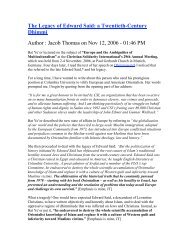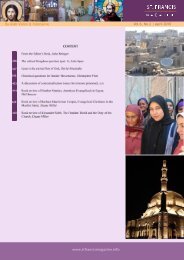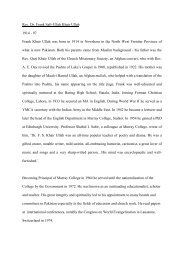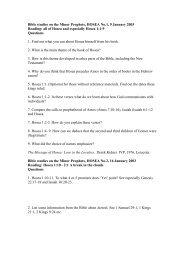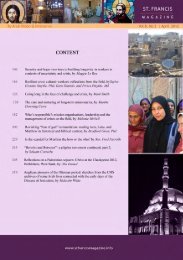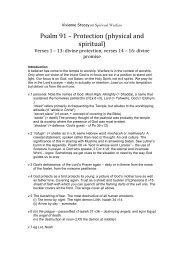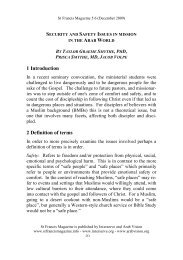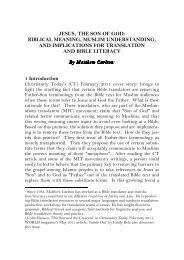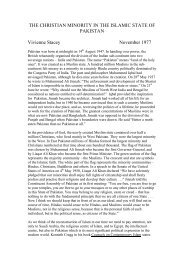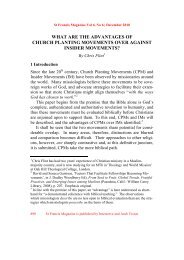Download the pdf - St.Francis Magazine
Download the pdf - St.Francis Magazine
Download the pdf - St.Francis Magazine
Create successful ePaper yourself
Turn your PDF publications into a flip-book with our unique Google optimized e-Paper software.
<strong>St</strong> <strong>Francis</strong> <strong>Magazine</strong> Vol 9, No 4 | August 2013<br />
Incidentally I have <strong>the</strong> impression that about <strong>the</strong> same period <strong>the</strong> Arabic Service of <strong>the</strong> British Broadcasting<br />
Company seemed to shift away from <strong>the</strong> dominance of standard Arabic, as more and more reporting from<br />
various areas included elements in non-standard Arabic (dialectical and "middle" levels), and even a few<br />
non-Arabs speaking imperfect Arabic in <strong>the</strong>ir areas of expertise. 119<br />
In <strong>the</strong> early 1990s, RSB began recruiting and training national believers to produce materials for<br />
<strong>the</strong> program in North Africa. This created a greater variety in voices and dialects, and a richness of<br />
materials produced in North Africa itself. 120 MSA remained <strong>the</strong> linguistic standard, though, which is<br />
clear from <strong>the</strong> agreement RSB made with GMU for <strong>the</strong>ir co-produced programs. The organizations<br />
agreed that <strong>the</strong> overall format was to be in MSA with inserts in North African colloquial Arabic.<br />
That arrangement did not work well, but it reflected RSB’s linguistic choices. In 1991, in its<br />
magazine Contact, RSB published that for <strong>the</strong> Let’s Walk Toge<strong>the</strong>r programs, RSB would continue to<br />
focus on MSA broadcasts, with Moroccan Arabic inserts it received from GMU; GMU would use<br />
Moroccan Arabic with MSA inserts it received from RSB and TWR. 121<br />
4. Program <strong>St</strong>rategy and Actual Programs<br />
4.1 Radio as <strong>the</strong> First Phase of Evangelism<br />
From <strong>the</strong> beginning of NAM’s thinking about producing radio programs, it decided that ‘national<br />
Christians’ were to be used as speakers and announcers whenever possible. There should be ‘a<br />
careful editing of material extra to <strong>the</strong> Scriptures’, and <strong>the</strong> ‘place of singing and music in<br />
programmes’ was to be ‘carefully considered’. NAM agreed that <strong>the</strong> ‘message [sic] to believers<br />
could provide a good though indirect approach to unbelievers’. 122 All <strong>the</strong>se ‘resolutions’ were made<br />
years before actual production began. The idea to broadcasts messages that seemed intended for a<br />
Christian audience was probably <strong>the</strong> result of NAM not wanting to aim directly at Muslims, for<br />
reasons of security.<br />
Throughout its existence, NAM has been formally and informally involved with <strong>the</strong> o<strong>the</strong>r<br />
Christian producers and broadcasters for <strong>the</strong> Arab world and, in that context, <strong>the</strong> organization has<br />
been discussing practical issues related to how to best produce programs for Arab Muslims. NAM<br />
seems not to have produced its own internal documents for whatever strategy it wanted to pursue.<br />
In 1966 Gaston, <strong>the</strong> first director of RSB, described why NAM was interested to be involved in<br />
radio broadcasting to North Africa. He did that during a conference of ELWA in Liberia. 123 In<br />
general, Gaston considered Arabs <strong>the</strong> ‘elite of Islam’ and <strong>the</strong>refore <strong>the</strong> key to <strong>the</strong> whole religion of<br />
Islam. He considered <strong>the</strong> Christian Arabs as <strong>the</strong> key to reaching all o<strong>the</strong>r Arab Muslims. 124 He<br />
probably thought of <strong>the</strong> Christians of <strong>the</strong> Middle East, as <strong>the</strong> church in North Africa was virtually<br />
non-existent. It seemed NAM had an instrumentalist view of <strong>the</strong>se Middle Eastern Christians. The<br />
language Gaston used gives <strong>the</strong> impression that <strong>the</strong> Christian Arabs were seen as tools for NAM for<br />
reaching Muslims. This was during a period when <strong>the</strong> word ‘partnership’ had not become bon ton<br />
yet.<br />
The interest of Gaston in Christian radio to North Africa was related to <strong>the</strong> fact that missionaries<br />
were expelled from countries like Tunisia and Libya. In 1966, according to Gaston, <strong>the</strong>re were only<br />
four missionaries left in Libya, 20 in Tunisia, 75 in Algeria, and 200 in Morocco. Gaston was glad<br />
that radio could be used in evangelism to reach closed countries, to reach a high number of illiterates,<br />
even in distant locations, and that it could speak to people every day in <strong>the</strong> seclusion of <strong>the</strong>ir<br />
homes. 125 The idea that NAM reached illiterates with radio was an illusion as <strong>the</strong> language of <strong>the</strong><br />
programs, MSA, was not understood by illiterates.<br />
119 Ibid.<br />
120 ‘An Eye to <strong>the</strong> Future’, in Contact (February 1993), p. 1.<br />
121 ‘Team Effort’, in Contact (February 1991), pp. 1-2.<br />
122 ‘Minutes of Meeting of Field Council held at Tangier (22-24 September 1959)’, p. 3.<br />
123 ‘Transcript of Meetings (10-11 May 1966)’, pp. 1, 5-7.<br />
124 Ibid., p. 6.<br />
125 Ibid., pp. 6-7.<br />
<strong>St</strong> <strong>Francis</strong> <strong>Magazine</strong> is published by Arab Vision and Interserve 17




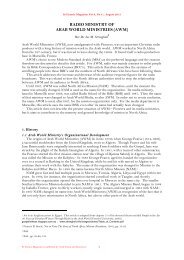
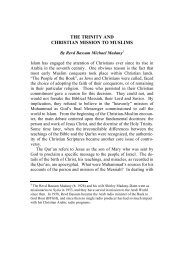
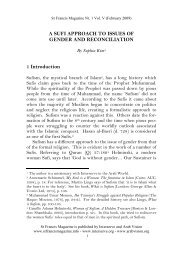
![Reflections on Surah Fatiha and the Lord's Prayer[1] - St.Francis ...](https://img.yumpu.com/49377951/1/184x260/reflections-on-surah-fatiha-and-the-lords-prayer1-stfrancis-.jpg?quality=85)
